This post may contain affiliate links. If you make a purchase through a link, I may receive a small commission, at no cost to you. These commissions help keep this website up and running, and I thank you for your support. Read my full disclosure here.
Disclaimer: This is not a sponsored post, I paid for this trip myself. All recommendations and opinions are my own.
We visited Plovdiv on our way from Burgas to the Rila Mountains. Plovdiv is the second largest city in Bulgaria and has a long and interesting history. It’s been invaded by a long list of people including Persians, Greeks, Celts, Romans, Goths, Huns, Bulgars, Slavs, Rus people, Crusaders, and Turks. This historic city features an old town, Roman ruins, and a stylish pedestrian shopping district. We only spent an afternoon there, but I think on reflection I would have preferred to have stayed the night so we could have explored more.
Roman Forum of Philippopolis
ul. “General Gurko” 12, 4000 Tsentar, Plovdiv
We drove to Plovdiv in a hired a car, so parked at Trimontsium ul Kapitan Raycho Nikolov 2, 4000 Tsentar which was centrally located and manned (and cheap!). The car park was just beside the Roman Forum which has a rather ugly abandoned building as it’s back drop, so it was challenging to get some nice photos of it. They discovered this site in 1971 when they were building the central post office and it is a large and sprawling site.
The forum is surrounded by the ruins of historic administrative buildings. This spot was once the centre of public, administrative, commercial and religious life in the ancient city of Philippopolis. This would have been where meetings, celebrations and state events were held. You can’t walk down into it, but you get good views from above.
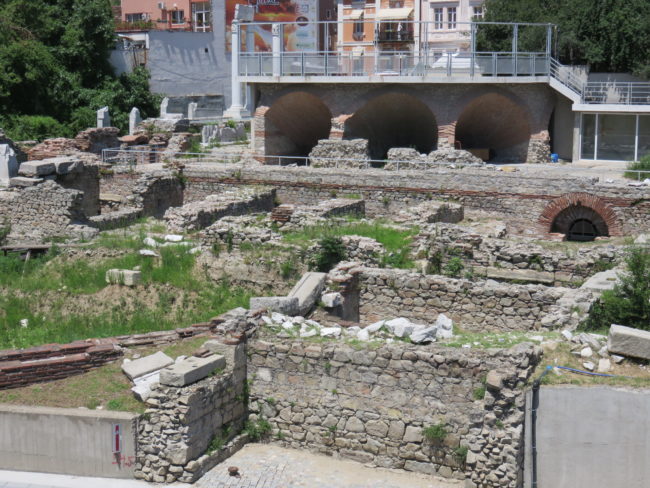
Enjoy the Local Food
We were hungry when we arrived, so we stopped to eat at Restaurant Gusto (Otets Paisiy Str. 26, Plovdiv 4000) which was at the more expensive end for Bulgaria, but still very reasonably priced. It was very hot so we enjoyed a large jug of lemonade and I had stew in a bread bowl. There was a nice outdoor seating area and the food was pretty tasty (I forgot to take a photo sorry).
Stroll Down the Pedestrian Shopping Street
The main pedestrian street (Knyaz Aleksander I or Aleksander Batenberg Street) runs for 1.7 km through the centre of town. This is not the actual old town, but it has beautiful historic buildings and a square featuring a fountain. It is also very well maintained and the area was beautifully decorated with flowers. The street is wide and although it was busy, it still had a laid back feel to it.

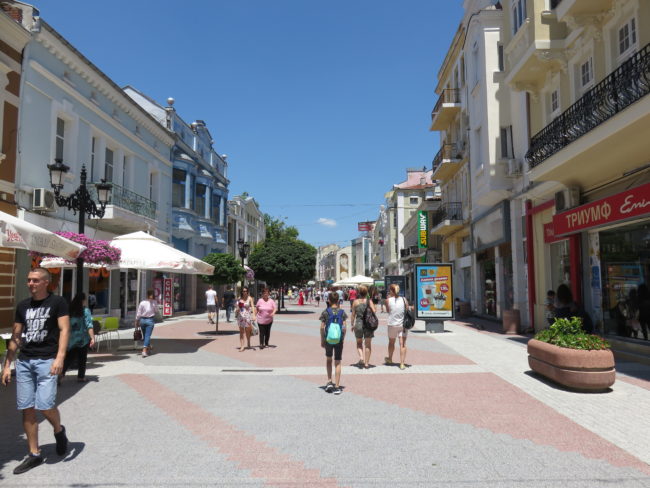
Dzhumaya Mosque
ul. “Zhelezarska”, 4000 Staria grad, Plovdiv
After heading down the pedestrian street, we eventually got to the Dzhumaya Mosque. Its Turkish name is Hüdavendigâr Camii or Cuma Camii. The mosque was built in 1363–1364 on the site of the Sveta Petka Tarnovska Cathedral Church after the Ottoman army took over Plovdiv. In the 15th Century, during the reign of Sultan Murad I, the old church was demolished and replaced by this large mosque. It features nine domes and a minaret. It’s wall paintings date to the late 18th to early 19th centuries.
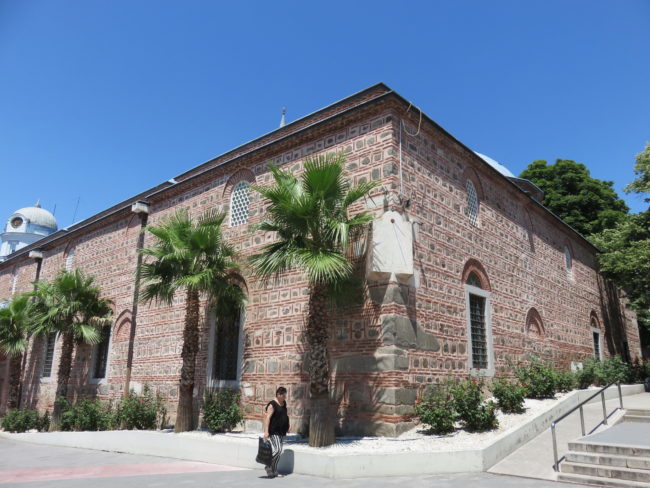
Ancient Stadium of Philippopolis
ul. “Hristo G. Danov”, 4000 Staria grad, Plovdiv
Just in front of the Dzhumaya Mosque is the steps down into the Ancient Stadium of Philippopolis. I was surprised to find that we did not have to pay to enter this amazing site. Part of the curved end of the stadium has been partially restored. This and the miniature replica on display really gives you a sense of how this stadium would have looked.
Apparently games similar to the Pythian Games in Greece were held here. The games were organised by the General Assembly of the province of Thrace. In their honour, the royal mint of Trimontium coined money featuring the face of the ruling emperor as well as the types of athletic events held in this Ancient Stadium. Athletes competed in two categories of age – men and boys and there was additional entertainment for the crowd including music, poetry and art contests.
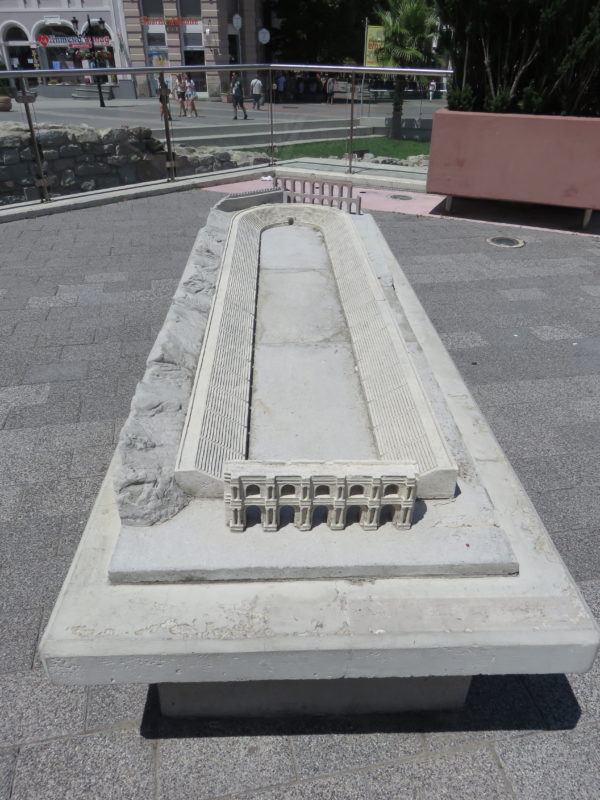
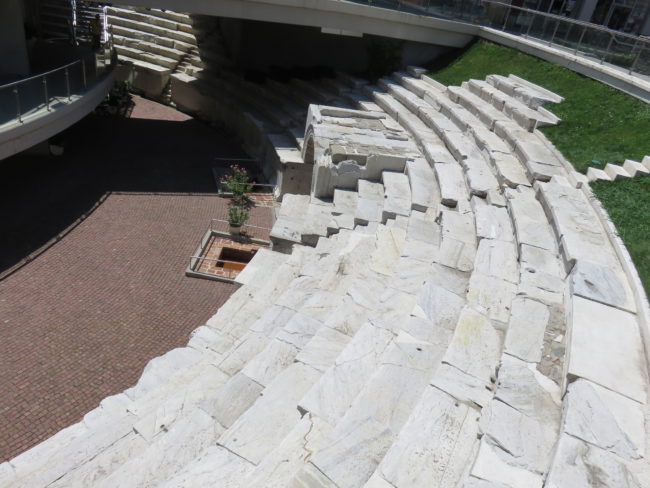
Eastern Orthodox Church (St Virgin Mary Church)
ul. “Saborna” 2, 4000 Staria grad, Plovdiv
We began our walk up the hill into the old town area. We walked up the steps to see the Eastern Orthodox church which dates back to 1844. As you come to expect from Orthodox churches, it was richly adorned inside with a lot of gold and imagery painted on the walls.
Across from the church is an interesting little stone building.
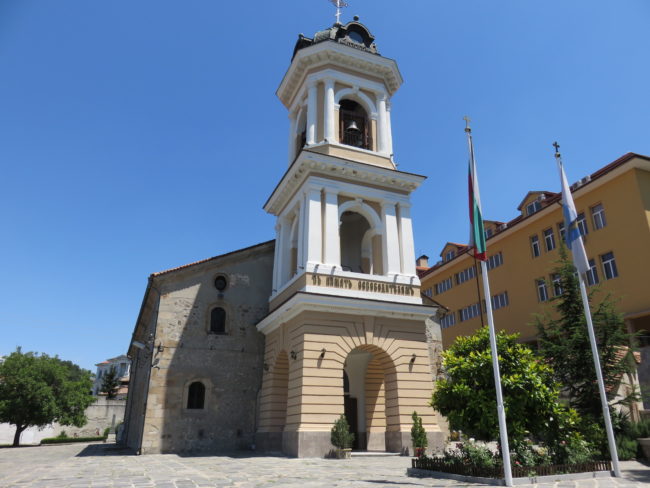
St. Dimitar Church
ul. “Todor Samodumov” 4000 Staria grad, Plovdiv
In the yard of St Dimitar Church was an amazing mural, but unfortunately they had some scaffolding up as they were doing some work on the building.
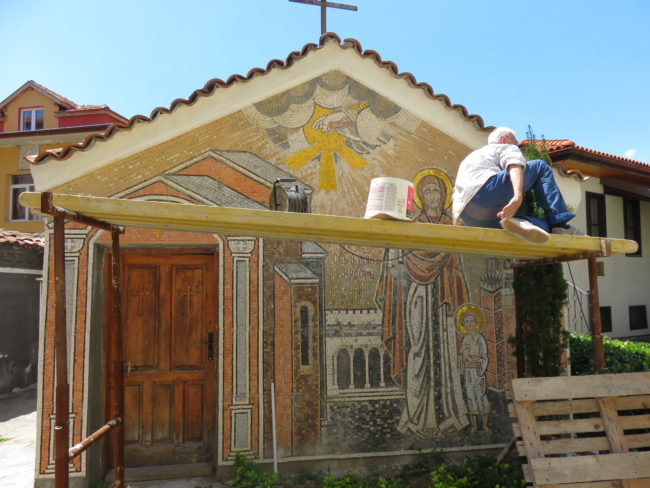
Plovdiv Old Town
We continued our walk up through the winding streets of the old town area. The roads are just chunks of uneven cobblestone worn away by years of traffic, you have to be careful not to twist an ankle! We took our time wandering the streets and admiring the beautiful historic buildings.
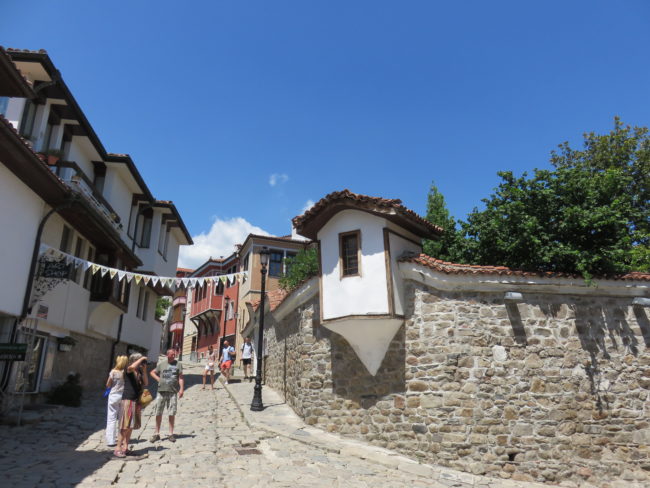
House-Museum Klianty
ul. “Todor Samodumov” 3, 4000 Tsentar, Plovdiv – entry fee applies
We visited the House-Museum Klianty which was built in 1816 and is one of the oldest preserved houses from this period. It fell to ruin, but was carefully restored and is now open to visitors as a museum. I enjoyed visiting it as I love historic homes, but I thought the price was a bit steep considering it is quite small. There was an informational video playing on a loop which went into detail about the history of the house and how it was restored.
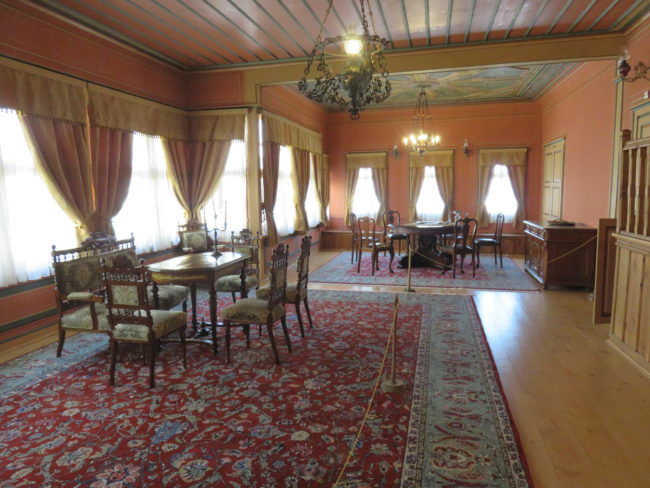
Lamartine’s House
4000 Стария град, Plovdiv
This beautiful historic home is not open to the public, but is significant for accommodating Alphonse de Lamartine who stayed here a few days. I had no idea who that was so had to Google it. Apparently he was a French writer, poet and politician who was instrumental in the foundation of the Second Republic and the continuation of the Tricolore as the flag of France.

The Old Pharmacy “Hippocrates” – House of Antoniadi
ul. “Saborna” 16, 4000 Tsentar, Plovdiv (entry fee applies)
Walking along ul. Saborna we found ourselves in the heart of the old town with many interesting buildings. There is an old pharmacy here in a house built in 1872 by Dr. Sotir Antoniadi, one of the first people with medical degree in Plovdiv. It is now the Museum of Pharmacy which tells of a time when medications and pills were made of natural ingredients.

Church of St Constantine and Helena
pl. “Hisar kapiya”, 4000 Staria grad, Plovdiv
Through a small arched door in a wall we found one of the oldest churches in the city, the Church of St Constantine and Helena. It was originally built in 337 at the sight of an ancient pagan temple in the acropolis on one of the fortified hills. The church was named after Emperor Constantine the Great and his mother Elena. However, over the years it was rebuilt several times and the current church was constructed in 1832. On the corner of the wall is a tall bell tower. We enjoyed the frescoes and icons painted on the outside, but didn’t venture in as there was a bride standing outside about to walk up the aisle. If your drink bottle needs refilling there is a water fountain just inside the gate on the right.
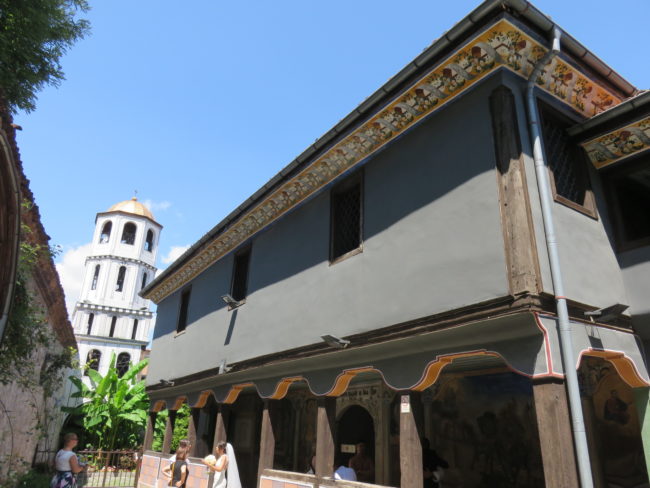
Regional Ethnographic Museum
ul. “Doctor Stoyan Chomakov” 2, 4000 Tsentar, Plovdiv, Bulgaria. Entry fee applies.
A little further up the cobbled street we found the beautiful garden oasis of the Regional Ethnographic Museum. Entry fee is quite reasonable as it does provide an insight into the history of the people of Plovdiv. The museum is interesting, but I think most people visit to admire the beautiful Kuyumdzhioglu House which was built in 1847 for the Plovdiv Greek merchant Argir Hristov Kuyumdzhioglu.
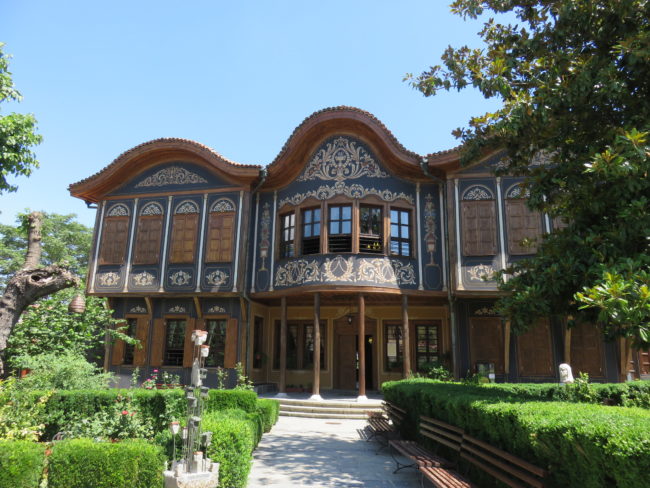
Hisar Kapia
град, pl. “Hisar kapiya” Стария, 4000 Tsentar, Plovdiv
Following the museum, we turned up the side street and walked through the medieval gate, Hisar Kapia. The gate was built in the 11th century AD over the foundations of a gate from Roman times.
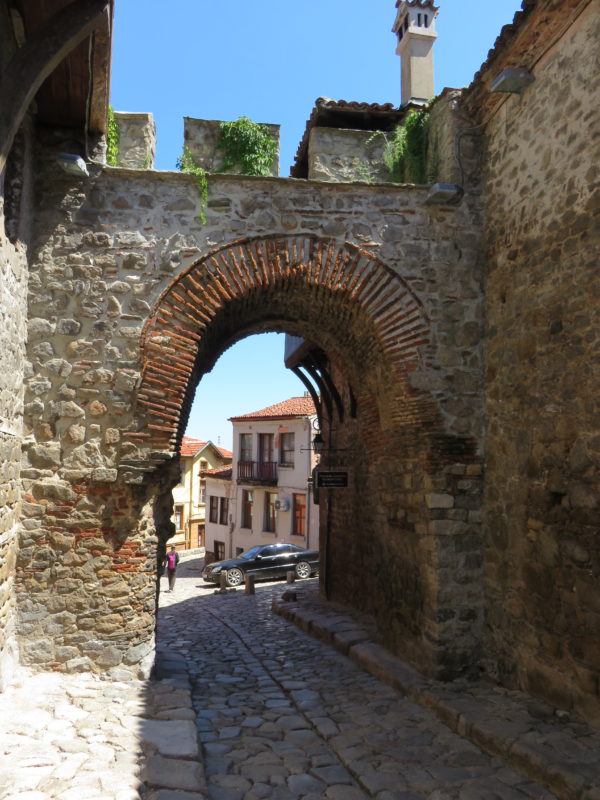
Historical Museum – Exhibition Renaissance
ul. “Tsanko Lavrenov” 1, 4000 Staria grad, Plovdiv
The Regional History Museum is housed in a beautiful traditional building. We didn’t have time to go in, but apparently it hosts a range of exhibits from firearms, medals, armament, apparel, photos and documents.
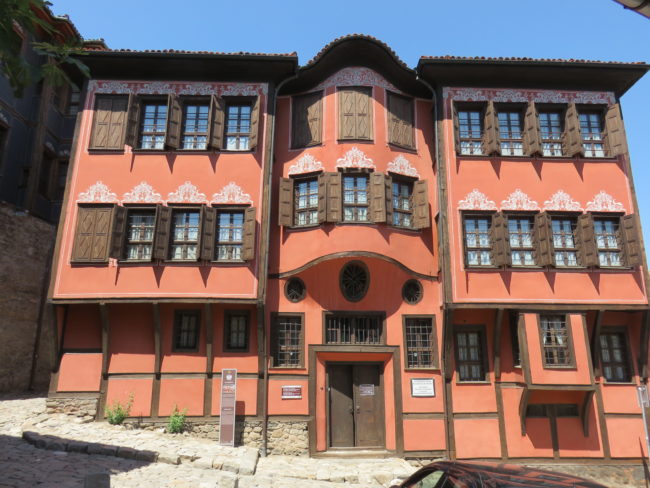
South Round Tower
ul. “Stramna” 9, 4000 Staria grad, Plovdiv
Around the corner to our right, we came upon the South Round Tower. The tower remains date back to the 3rd century, when it was part of the ancient fortress wall protecting the city of Philippopolis.
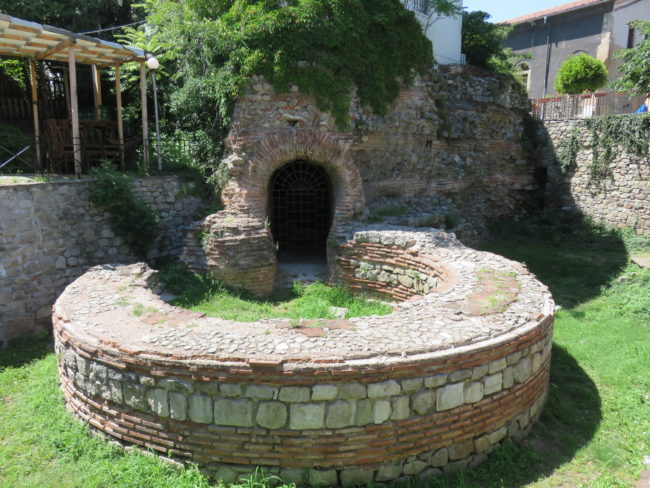
Ancient Theater of Philippopolis
Ул.”Цар Ивайло 4, 4000 Tsentar, Plovdiv
This Roman theatre was built in the 1st century AD. Couldn’t get in to the Roman amphitheatre as they were setting up for a performance. It is hard to believe that this theatre was only discovered following a landslide in the 1970’s. Following its restoration, it is now used for summer theatre and music performances. When they were setting up for a performance.

Enjoy an Ice Cream
If you are visiting in summer like we were, Plovdiv gets very hot, so we cooled off with a large ice cream from Raffy’s (5, Център, ul. “Patriarh Evtimiy”, 4000 Plovdiv) which is a popular chain in Bulgaria and serves very yummy ice creams.
Garden of Tsar Simeon
ul. “Veliko Tarnovo” 11А, 4000 Plovdiv
On our way back to the car, we took a cool stroll under the tree canopy in the Garden of Tsar Simeon which was beside the car park. This is a lovely peaceful spot to escape the heat of the summer.
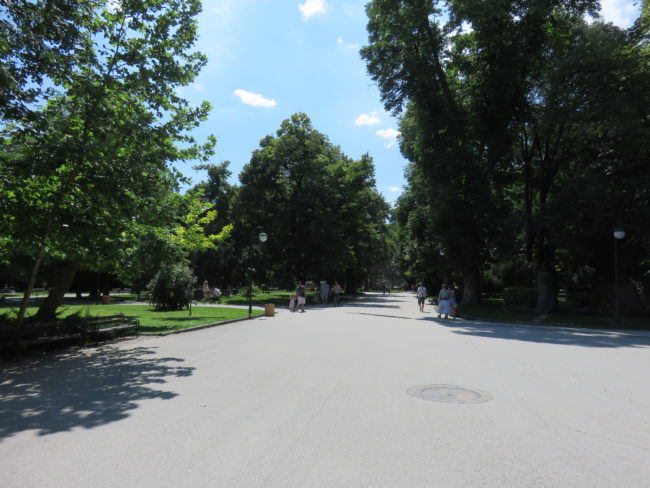
Accommodation Options in Plovdiv
Search available accommodation in Plovdiv
Budget
Moderate
Luxury
Practical Tips for Visiting Plovdiv
- How long should I visit Plovdiv for? Despite its small size, there is a surprising amount to do in here. We had only scheduled an afternoon, but on reflection I wish we had spent the night there.
- How to get to Plovdiv:
- By car: We parked at Trimontsium ul Kapitan Raycho Nikolov 2, 4000 Tsentar which was centrally located and manned (and cheap!).
- Public transport: You can get to Plovdiv by train or bus from Sofia and Burgas.
- Tour: You can visit Plovdiv on a day tour from Sofia
- Free walking tour: If you want to learn more about this amazing city, join the Plovdiv free walking tour.
- Respect: When visiting the churches and mosques, you need to ensure your legs and shoulders are covered. They also ask you not to take photos.
- Drinking fountains: There are public water drinking fountains dotted around the city. It is great in the hot summer sun to be able to refill my drink bottle.
- Language: Bulgarian. It can be difficult to understand signs when they are in Bulgarian, as it looks nothing like the English version. Many of the areas we visited in Bulgaria only limited people spoke English, so we tried to make an effort with some Bulgarian. I encourage you to try a little Bulgarian too. Fun fact – Bulgarians nod when they say no and shake their head when they mean yes.
- Yes = да (da)
- No = не (ne)
- Please = моля (molya)
- Thank you = благодаря (blagodarya)
- Hello = добър ден (dobar den)
- Where is the toilet? къде в тоалетната (kade e toaletnata)
- Currency: Bulgarian Lev, or Leva, which is the plural. Most places had card machines and there were plenty of ATM’s. However, you will need small change for the buses.
- Electricity: The electrical current is 220-240 volts, 50-60 Hz. Wall outlets take the European two round prong plugs. However, you are better off purchasing a worldwide adaptor that can be used in Bulgaria as well other countries. At least then you can potentially get some further use out of it on future vacations. If you’re taking a number of electronics with you, then I would recommend purchasing a couple of these adaptors.
- Driving: In Bulgaria they drive on the right hand side of the road with speed signs in kilometres per hour (km). The speed limits are 50 km (31 mph) within towns; 90 km (56 mph) outside towns; 120 km (75 mph) on expressways; and a rather scary 140 km (87 mph) on motorways. Some of the roads we drove on were very old with huge pot holes and the paint had long since faded, so we had to drive slower in these areas.
- Navigating: We used Google’s free Offline Maps. Google Offline Maps allows you to access free maps for navigating that can be used offline i.e. you don’t need WIFI, data, or roaming to be able to use them. Follow this detailed guide on how to use Googles Offline Maps. Using your phone as a GPS will drain your battery quickly, so use a portable battery charger which you can use to charge your phone and any other USB chargeable devices. If you prefer a paper map, then purchase a Bulgarian road map before you go. At least it’s reliable and won’t run out of battery or malfunction like the electronic options!

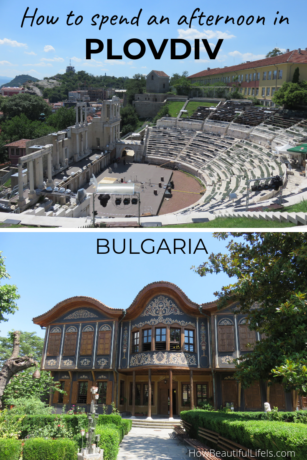
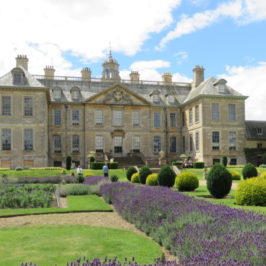
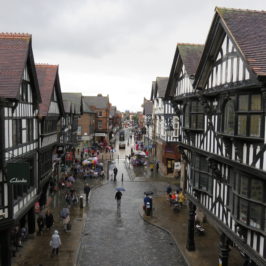
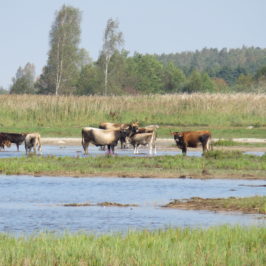
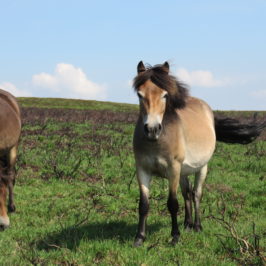
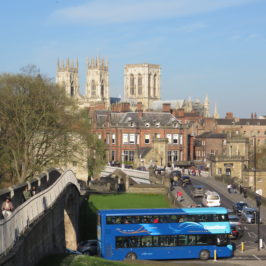
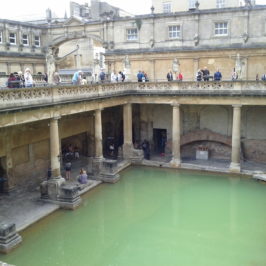
Leave a Reply